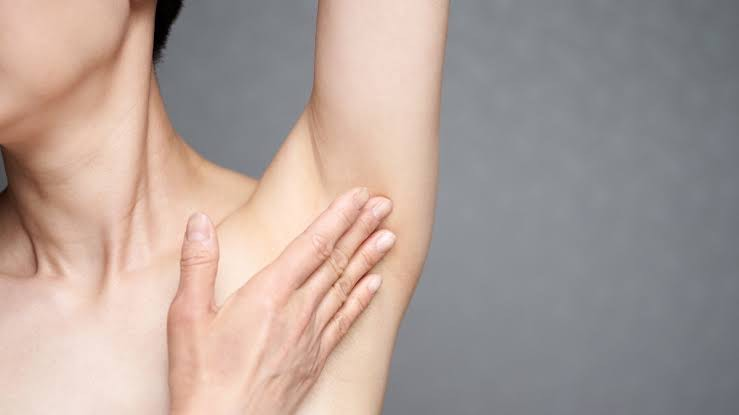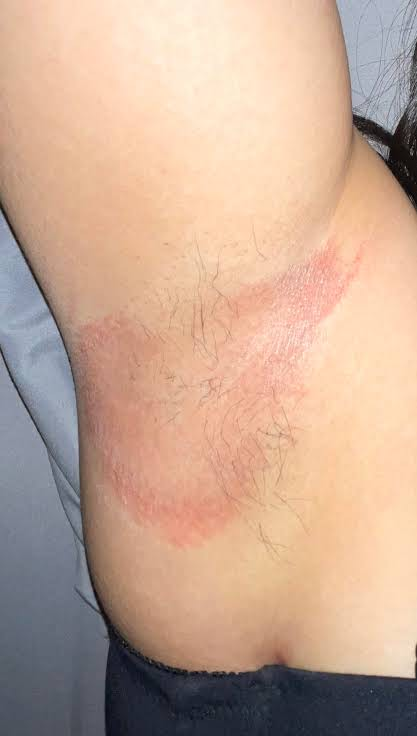
[ad_1]
Armpit rashes are tiny, smooth, and dry bumps that are uncomfortable on the skin. Oftentimes, these rashes will only last a few hours on the skin. However, it becomes even more concerning when it takes a long time to clear up.
Armpit rash is a reaction often triggered by irritants or allergens, or underlying conditions. It can vary from mild to more complicated depending on the cause.
This post identifies different possible causes of an armpit rash and provides treatment options to consider depending on the causes of the armpit rash.

What are the Causes of Armpit Rash?
You’re probably thinking about the things that could have caused your underarm rash. It’s normal to be worried, especially if it keeps recurring. Here are some of the things causing bumps, redness, and dryness in your underarms:

Heat
One of the top irritants that causes underarm rash is heat. A heat rash is a cluster of tiny pimply rashes or blisters that might feel itchy or painful.
You are mostly going to experience a tiny heat rash on your underarms when exposed to heat. The excess sweating and oil can block your sweat glands, which then causes heat rash.
However, heat rash doesn’t take much time to clear up. You can apply lotion or prickly heat-cooling powder to clear the itchy rash.
Contact Dermatitis
Contact dermatitis rashes occur as a result of your contact with any irritants or allergens, triggering an immune response. This is often an allergic reaction to a substance that comes in contact with your skin. If you have sensitive skin, some products like shaving cream, soap, cream, deodorant, and antiperspirant can cause armpit rashes.
You may not notice any skin reaction till maybe days or weeks after you start using a product that irritates your skin. In the case of contact dermatitis, the rash often looks red and more bumpy. It could also appear like blisters on the area the allergen touched.
Whether your armpit rash is caused by allergic contact dermatitis or irritant contact dermatitis, you want to take your time to figure out the product that your body is reacting to. Contact dermatitis can recur unless you avoid the allergen or irritants causing the rash.
Folliculitis
Shaving is also one of the top causes of armpit rashes. If you notice armpit rashes after shaving your underarms, this is because your hair follicles are irritated.
Folliculitis is a mild pimply rash that occurs when you shave wrongly. This type of underarm rash is red, tiny, and painful bumps caused by ingrown hairs or the friction of your shaving razor against your skin. You might experience itchiness, burning, or inflammation in the area after shaving.
You might have to avoid shaving for a while until your skin rash heals.
Candida Infection
Armpit rashes can also be a result of fungal infections that affect moist areas of the skin that are not exposed to air. Also known as yeast infection, this causes swelling, redness, itchiness, and scaly rash.
Some of the causes of candida infection include; hot weather, poor hygiene, tight clothing, and a weakened immune system. To prevent armpit rash caused by this infection, you want to prevent a buildup of moisture in your underarm area.
Inverse Psoriasis
Compared to other skin reactions caused by an infection, this is an inflammatory skin condition that is caused by psoriasis disease. It mostly affects the armpit or other areas of the body where skin folds.
Apart from the underarm, inverse psoriasis can appear in areas where the skin rubs like the genital area and behind your knees and elbow.
Inverse psoriasis is unique to the touch because it feels smooth and defined on the skin. For people with darker skin tones, the armpit rash may appear grey, darker, or purple. On lighter skin, rashes caused by inverse psoriasis are red.
You might also experience something unlikely like an awful smell, or itchy, and moist underarms. This type of rash is often found in the sensitive part of your body and might require a proper diagnosis.
Ringworm
This is a fungal skin infection that causes armpit rashes. While one would think this type of rash is caused by a worm, ringworm or Tinea Corporis is a fungus.
Ringworm underarm rashes appear red and raised with scaly patches. These armpit rashes grow in a circle and feel itchy. Also, ringworm rashes look dry, swollen, and blistered.
Seborrheic Dermatitis
These are underarm rashes that block your oil glands. Seborrheic dermatitis is a skin infection that is caused by excessive skin oils. They often appear white or yellow in the form of patches, flakes, and scales.
Armpit rash caused by seborrheic dermatitis also appears swollen, itchy, greasy, and red. This is a type of eczema rashes, which is a chronic inflammatory skin condition that might occur in people who have eczema.
Atopic Dermatitis
Atopic dermatitis is a chronic skin condition also known as eczema that causes inflammation and rashes on different parts of the body like the armpit. This condition affects the skin barrier and weakens the immune system, making the skin vulnerable to irritants and allergens.
This condition causes inflammation of the skin, crusting, itching, dryness, and scaling. The patches might also release fluids. While it is itchy, you want to avoid scratching so you don’t worsen the symptoms and further damage your skin.
Chafing
Chafing occurs when skin rubs against itself or clothing for an uncomfortable amount of time. Chafing can affect your armpit because it’s a part of the body where the skin folds and rubs against itself, leading to armpit rash.
Chafing will most likely occur in the summer and spring months because that part of your skin is moist and more susceptible to irritants.
Chafing rashes appear red and swollen, and the top of your skin might look dark. This armpit rash might also give you a burning sensation. It can also bleed out if it is severe.
Hidradenitis Suppurativa (HS)
Hidradenitis suppurativa (HS), commonly referred to as acne inversa, is a skin condition that causes small and painful bumps on areas where the skin rubs together, like the underarms, buttocks, breasts, and groin. This starts by blocking the hair follicles in the apocrine sweat glands.
This type of armpit rash may appear pus-filled and painful, reddish, or darker, depending on your skin color. However, this can worsen with time causing the pus fluid to ooze with a foul smell. It can also cause scarring on the skin when the bumps get ruptured.
Treatment options might differ based on the severity of the skin condition.

What to Do to Prevent Armpit Rash?
Armpit rash often occurs when you come in contact with an irritant or when your skin rubs aggressively together. Embracing some self-care changes can help prevent the rash. They include:
- Choose skincare products that don’t irritate your skin. You want to be careful when choosing your soaps, deodorants, detergents, and creams.
- Wear loose clothing made with breathable fabrics, especially in the summer and spring seasons.
- Apply oil or anti-chafing powder your skin on areas where your skin rubs to reduce chafing.
- Keep your armpit cool and dry always. Shower regularly if you sweat a lot because you don’t want a build-up of moisture.
- Manage any underlying skin conditions that can cause flare-ups.
- Apply unscented moisturizers on your underarm.
Treatment Options to Consider for Your Armpit Rash
From OTC medications to home treatment, there are so many treatment options to consider. This treatment also depends on the causes of the armpit rash.
Home Treatment for Armpit Rash
This is a simple treatment that you can easily use to relieve the symptoms of your rash like itchy skin. If your armpit rash is caused by allergic contact dermatitis or skin irritation, you can try this treatment.
- Use a cold compress to control itchiness or swelling.
- Shower regularly to keep your skin cool and dry.
- Avoid tight clothes that can rub aggressively against the skin.
- Apply unscented moisturizers or heat-cooling powder on your scaly rashes consistently.
- You can also apply oatmeal, salt, vinegar, or baking soda into a lukewarm water to bathe.
- Avoid scratching or shaving until the rash on your armpit heals.
- Try applying essential oils, such as lavender or tea tree into your bathing water to kill fungus
Supplements
You can also consider using natural remedies to treat your armpit rash. This is recommended for chronic skin conditions like eczema. This includes applying treatments to manage and prevent triggers.
- Reduce stress
- Coconut oil
- Sunflower oil
- Vitamin D supplements
- Topical vitamin B12
Prescription Medication
Chronic skin inflammation requires prescription medications to manage. This is another appropriate treatment to consider after you have tried home remedies without seeing any changes. These treatment options include:
- Topical steroids cream
- Topical calcineurin inhibitors
- Topical PDE4 inhibitors
- Phototherapy
- Medications that contain human immune proteins
OTC Medications
If your armpit rash is a result of skin infection or allergic contact dermatitis, you might want to try some over-the-counter medical treatment options. However, it is best to consult your doctor because getting any OTC medications for a proper prescription.
OTC medications for armpit rashes include:
- Calamine lotions to reduce inflammation
- Antifungal creams, gels, or sprays for yeast infections
- Hydrocortisone creams for eczema or contact dermatitis
- Antihistamine medications to manage itching
Treatment Options for Seborrheic Dermatitis
Some effective treatments for seborrheic dermatitis include:
- Antibiotic ointments
- Topical Corticosteroids
- OTC antifungal creams
- Skin softening treatments
When Should You Visit the Doctor for Your Armpit Rash?
While rashes tend to go away on their own or can be easily managed with home treatment, there could be cases of complications if the fungal or bacterial infection remains untreated.
To prevent any complications, such as sepsis, organ failure, or allergic rhinitis, you need to know when to visit the doctor. You want to visit your doctor when:
- Your rashes are painful or swollen with blisters
- Bleed, smells, or release pus
- Your armpit rashes spread to the surrounding skin
- You are experiencing vomiting, constipation, nausea, or diarrhea
- Rashes aren’t responding to home treatment or over-the-counter prescriptions
- You feel dizzy, confused, or stiff-necked
- Rashes develop rapidly alongside cold hands and feet
- Your body is suddenly shaking without control
- You feel feverish
Wrapping Up
Armpit rashes may occur due to mild or more complicating factors that you need to quickly manage to prevent discomfort or pain in your underarms.
Treatment options for armpit rash vary according to the severity of the rash. It could be oral medications, antifungal medication, or natural treatment.
Most armpit rashes can be treated with a mixture of at-home treatment and OTC medications. In cases where these don’t work, you might have to consider prescription medications.
It is highly advised that you figure out any product that irritates your skin or can trigger allergic reactions like rash. You also want to avoid a humid environment that can make your skin moist, so keep your armpit cool and dry always.
I hope you found this content helpful. What is your go-to treatment for armpit rash?
[ad_2]